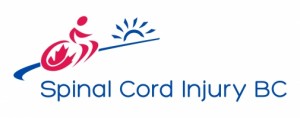 In this issue, we introduce you to our visitors from Kentucky, show off some projects from our basement, give you some good reasons to support the Spinal Chord Gala, and report on the interesting history of SCI treatment. Plus: our regular column by former PhD student Dr. Jessica Inskip and some fun events to keep you busy for the rest of the summer.
In this issue, we introduce you to our visitors from Kentucky, show off some projects from our basement, give you some good reasons to support the Spinal Chord Gala, and report on the interesting history of SCI treatment. Plus: our regular column by former PhD student Dr. Jessica Inskip and some fun events to keep you busy for the rest of the summer.
 “It’s a once in a lifetime opportunity,” says Kathryn Harman, about winning a VISIT Program trainee award with her colleague Kathryn DeVeau.
“It’s a once in a lifetime opportunity,” says Kathryn Harman, about winning a VISIT Program trainee award with her colleague Kathryn DeVeau.
The two scientists won VISIT (Visit ICORD on a Scholarship for International Trainees) awards last year. With funding generously provided by the Rick Hansen Foundation, ICORD established the awards to facilitate trainee exchanges with research institutions around the world. The PhD candidates, also known as “the Katies” at ICORD, arrived earlier this summer from the University of Louisville’s department of Anatomical Sciences and Neurobiology.
DeVeau and Harman’s project with Dr. Andrei Krassioukov is to research the effects of different types of exercise on the recovery of the cardiovascular system following a spinal cord injury. They are building upon research done in ICORD’s Krassioukov Lab by former postdoctoral fellow Dr. Christopher West (who is now an ICORD Principal Investigator himself) that  has shown passive hind limb cycling to be helpful in improving cardiovascular function in rats after SCI. The VISIT winners will be comparing the effects of that exercise with an active swimming exercise that they have studied extensively in Louisville.
has shown passive hind limb cycling to be helpful in improving cardiovascular function in rats after SCI. The VISIT winners will be comparing the effects of that exercise with an active swimming exercise that they have studied extensively in Louisville.
DeVeau and Harman have been thrilled with the chance to work in the unique environment of ICORD, where they have access to such a diverse pool of expertise.
“ICORD really does something that a lot of people strive to do and that’s connect the bench to bedside and backwards, bedside to bench,” says DeVeau. In Louisville, opportunities for collaboration between clinical and research scientists are rarer, according to the two. DeVeau and Harman agree that they’re getting an invaluable experience from seeing how experiments in the lab inform treatments in the hospital and vice-versa.
“It’s really important to look at what you’re doing in your lab and try to think about how that can translate to the human population,” adds Harman. “We talk a lot about that here. It’s important to bounce ideas off each other and not be under a rock the whole time, and know that what you’re doing will actually make a difference.”
Since arriving in June, the Katies have been very grateful for the warm welcome from ICORDians and are adapting to life in Vancouver. DeVeau has even managed to play some soccer in her spare time. However, most of their days has been taken up with a busy work schedule, which will likely continue until their stay at ICORD ends in September.
If you, or someone you know, is interested in applying for VISIT program funding, please note that the next competition will take place this fall. Contact us for more information.

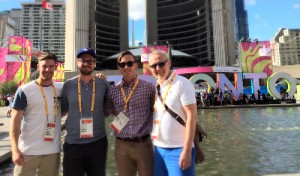 Dr. Andrei Krassioukov is leading a team of ICORD researchers in Toronto at the Parapan Am Games this August. Click here to find out what’s new about this cardiovascular health clinic for athletes.
Dr. Andrei Krassioukov is leading a team of ICORD researchers in Toronto at the Parapan Am Games this August. Click here to find out what’s new about this cardiovascular health clinic for athletes.
 Funds raised through the annual Spinal Chord Gala have given been used to purchase top-of-the-line equipment, making research and collaboration more accessible.
Funds raised through the annual Spinal Chord Gala have given been used to purchase top-of-the-line equipment, making research and collaboration more accessible.
Drs. Cornelia Laule and John Kramer are working together with their new Brain and Spinal Cord Imaging Analysis workstation, purchased with an equipment grant made possible by the gala. The researchers are studying the causes of pain in people with spinal cord injury. The state-of-the-art computer with a high resolution monitor was custom-built for the researchers to allow them to quickly process MRI images of the spinal cord and make visual analysis easier.
 “The goal was to make neuroimaging more accessible. To process and analyze images, you need a very fast computer, capable of multi-tasking. In the end, this will make our work more efficient,” says Dr. Kramer.
“The goal was to make neuroimaging more accessible. To process and analyze images, you need a very fast computer, capable of multi-tasking. In the end, this will make our work more efficient,” says Dr. Kramer.
Dr. Kramer hopes that others at ICORD will be able to use the workstation’s power for their own applications and spark more collaboration between investigators. “It has already brought the Laule and Kramer labs together; hopefully, more will become interested,” he says.
Dr. Jaimie Borisoff has already started working with Dr. Kramer and a UBC computer science student to create virtual reality environments to be navigated with Oculus Rift, the head-mounted virtual reality gaming display. The goal is to assess higher-order brain functions in people with SCI. Use of Oculus Rift wouldn’t be possible without the computing power of the new work station.
“It’s pretty cool,” says Dr. Kramer.
To support more cutting-edge research at ICORD, please come to this year’s Spinal Chord Gala on October 24th.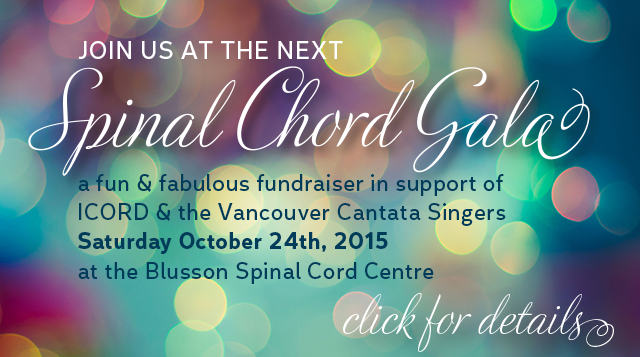

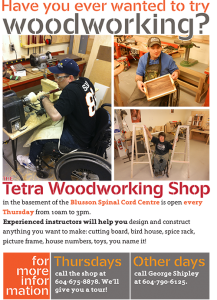 If you’re a regular ICORDian reader, you probably already know that there’s more than research going on here in the Blusson Spinal Cord Centre.
If you’re a regular ICORDian reader, you probably already know that there’s more than research going on here in the Blusson Spinal Cord Centre.
But did you know that twice a week people with disabilities can get help with their woodworking projects in the basement? The Tetra Woodworking Shop has been going strong for four years, with some beautiful projects to show for it.
The workshop opened its doors in February 2011 with startup funding from the Tzu Chi Foundation and space provided by ICORD. With ongoing support from the Tetra Society and some dedicated volunteers, the workshop matches experienced instructors with community members to create all kinds of projects, from bird houses to coffee tables, and almost everything in between. Apart from one student, all the volunteer instructors are retired (banker, architect, scientists, consultants, engineer, teacher).
The workshop is open to anyone with a physical disability. If you’d like to check it out, contact George Shipley (604-790-6125).
Click here to see a slideshow of some of the projects created in the workshop over the past two years.
New ICORD staffer Simon Liem has been researching historical treatments for spinal cord injuries. Want to know what he learned?
 Ancient history until the 19th century
Ancient history until the 19th century
The earliest known mention of spinal cord injury was found in the Edwin Smith surgical papyrus, in which an anonymous Egyptian author described SCI’s effects in great detail, but concluded that it was “an ailment not to be treated.” The grim prognosis sounded by the 4,500-year-old document–what is thought to be the oldest surviving scientific text–would echo throughout history. Despite little expectation of recovery from SCI, however, understanding the spine and how to heal a damaged one has been a subject that has continually fascinated some of the world’s most celebrated minds.
In his detailed studies of anatomy, Leonardo da Vinci remarked upon the quick death of a frog that had had its spinal cord pierced. Sushruta, the Indian “father of plastic surgery,” who lived between 1000 and 800 BC, wrote in the Sushruta Samhita that a simple fracture of the back was a case “to be given up as hopeless.”
Greek physicians, though not any less pessimistic, contributed greatly to the understanding of SCI and methods of treating it. Hippocrates (470–410 BC) advised that familiarity with the spine was necessary for knowledge of other diseases and created methods of traction to treat and align injured spines.
Galen (129–200 AD), often called “the second Hippocrates,” described how the effects on motor and bodily functions changed depending on the area of the spine damaged. He wrote of an occasion when he was able to relieve numbness in the fingers of a clumsy sophist who had fallen from a mount by treating a spinal nerve that he had identified as being connected to the hand.
Paul of Aegina (625–690 AD) developed laminectomy, or decompression surgery, the procedure of removing pieces of the spine to relieve pressure on the spinal cord and nerves. The Byzantine physician was the first to advocate for surgery to treat SCI.
Later, Arabic doctors’ advancements in pharmaceutical and surgical methods slowly disseminated throughout Europe in the Middle Ages. Techniques and attitudes evolved and fluctuated, but until 19th century the contributions to the fledgling field were more in the form of knowledge rather than clinical success.
19th century to modern times
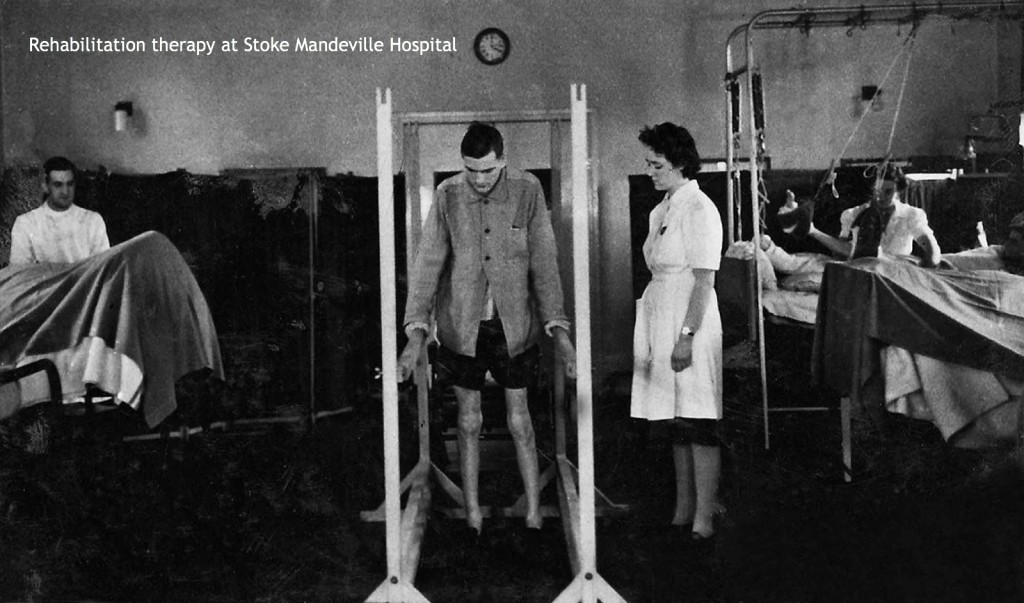 Modern treatments of SCI only took shape in the 19th century upon a wide-ranging wave of medical advancements: developments in anaesthetics, antibiotics, microbiology, hematology, radiography, surgery, and many others fields made the prospect of treating SCI more viable. Along with the technological and scientific progress, concepts of care broadened beyond dealing with the injury in isolation.
Modern treatments of SCI only took shape in the 19th century upon a wide-ranging wave of medical advancements: developments in anaesthetics, antibiotics, microbiology, hematology, radiography, surgery, and many others fields made the prospect of treating SCI more viable. Along with the technological and scientific progress, concepts of care broadened beyond dealing with the injury in isolation.
Donald Munro, an American neurosurgeon, is one of the most recognized for changing conceptions about SCI. He founded the first spinal cord unit in the United States in 1936, at the Boston City Hospital. His approach flouted the historical attitude that SCI was “an ailment not to be treated” by combining broad medical interventions, notably focusing on bowel and bladder management, with physical and occupational therapy. In Munro’s practice, recovery from injury not only meant survival, but regaining a productive and dignified life.
Munro’s work directly influenced Ludwig Guttmann’s founding of the SCI unit at the Stoke Mandeville Hospital in the United Kingdom. Guttmann was a Jewish neurosurgeon who fled Germany in 1939, and he, like Munro, took a more comprehensive approach to rehabilitation. His enthusiasm for sports therapy for people in wheelchairs led to the Stoke Mandeville Games, which eventually became the today’s Paralympic Games.
Both doctors were beginning their work in the 1930s and 40s when the survival rate of those with SCI was only 20 per cent, and a hopeless attitude toward treatment was still prevalent. The World Health Organization credits the beginnings of effective SCI treatment to Munro and Guttmann, whose work became the model for SCI care for the rest of the century.
In recent decades, research and technology has developed quickly. One exciting area of study is the use of stem cells for spinal cord regeneration after injury, pursued in many laboratories around the world. ICORD is one of the organizations at the forefront of this science. In 2015, Dr. Wolfram Tetzlaff and his team published a paper on the use of Schwann cells, a cell that aids in nerve fibre regrowth after an injury, derived from the skin. They hope the method will be a safer way of gathering the cells than having them excised with additional surgery (normally in the leg), which comes with a great risk of infection and further nerve injury.
This is only a small part of the research being done at ICORD and around the world in an effort to refute the ancient idea that SCI is “an ailment not to be treated.”
By Dr. Jessica Inskip (@jessinskip), former PhD Student in Dr. Victoria Claydon’s Lab at Simon Fraser University
The PhD Defense: grueling but ultimately satisfying
The PhD Defense is the final hurdle in the long marathon of the PhD. It is a public event where students present the 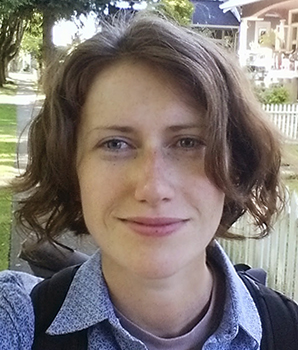 research that they have done over the last four years (…or five, or six!) to local professors, other students, and international experts in their research topic. This rite of passage is as nerve-wracking as it sounds: after a half-hour presentation summarizing years of work, the experts start two rounds of ask-me-anything. Normally their questions are related to the research project (e.g., “Why did you decide to study people with tetraplegia in your research?“), but sometimes the links are tenuous (“Why do lizards regrow their tails?”) or the questions are almost unintelligible (“So, about Figure 9…”).
research that they have done over the last four years (…or five, or six!) to local professors, other students, and international experts in their research topic. This rite of passage is as nerve-wracking as it sounds: after a half-hour presentation summarizing years of work, the experts start two rounds of ask-me-anything. Normally their questions are related to the research project (e.g., “Why did you decide to study people with tetraplegia in your research?“), but sometimes the links are tenuous (“Why do lizards regrow their tails?”) or the questions are almost unintelligible (“So, about Figure 9…”).
I feel qualified to tell you about this process having recently survived my PhD defense at SFU this summer. It was a grueling 165 minutes of adrenaline, and the heat wave in Vancouver meant that I wasn’t the only one sweating! The meeting Chair (aka the referee, who ensures that all of the examiners play by the rules) was also sweating due to the technical difficulties of trying to have my international expert Skype in from the Bronx.
Despite the heat, Skype-fail, and statistics stickler who grilled me on problems that plague the field of neuroscience (small number of participants, a lot of variability), it was pretty cool to spend a few hours discussing my research with some of the leaders in the field. Having my friends and family watching (and smiling and winking!) also helped to make it more enjoyable.
The outcomes of the PhD defense can vary between a) A LOT of work revising your thesis; b) a little bit of work revising your thesis; or c) a homerun (meaning you can submit your thesis as is!). There are very few of the latter (ICORD’s Dr. Ward Plunet may be one of the lucky few!). I snuck by with a b) and about a week’s worth of revisions to the written thesis. Then it’s just a matter of printing it into a book and getting your degree and funny hat at graduation!
Factors influencing physical activity behaviour: what gets people moving?
If you are 18-60 years old and had a traumatic SCI more than a year ago, ICORD researcher Dr. Christopher West and visiting McMaster University PhD student, Jasmin Ma, could use your help with a project. They want to know about the factors that influence how you participate in physical activities, and the role that your physiotherapist plays in promoting an active lifestyle. All you need to do is complete a survey, which should take about an hour. Compensation is provided.
For more information or to sign up to participate, please contact Jasmin by email or call 613-329-1849.
Imaging the spinal cord: does pain matter?
ICORD researchers Drs. Cornelia Laule and John Kramer, along with Drs. Shannon Kollind and Erin MacMillan, are investigating the causes of neuropathic pain after spinal cord injury. They are currently recruiting participants for their study, entitled Relationship between cervical spinal cord microstructure, metabolite concentrations, and neuropathic pain after spinal cord injury.
You can participate if you have traumatic SCI between C4 and T12. Individuals with and without neuropathic pain are welcome. You’ll have two to four sessions of MRI, as well as a visit at ICORD to undergo a neurological exam.
If we better understand the causes of neuropathic pain, ultimately we might be able to come up with ways of managing pain symptoms. If you have an interest in seeing your spinal cord and brain, we can also provide images!
For more information or to sign up, contact Dr. Kramer by email or call 604-675-8876.
Effects of physical activity and sympathetic cardiac regulation on cardiac function in individuals with chronic spinal cord injury.
How does physical activity relate to the health of your heart if you have a spinal cord injury? Does it make a difference whether you have a cervical or thoracic SCI? ICORD researcher Dr. Christopher West is looking for people to help him find out. If you had a traumatic SCI above T1 or below T5 more than a year ago, you can help with this study.
If you participate, you’ll take part in two two-hour visits to the Blusson Spinal Cord Centre where researchers will take some measurements of your cardiovascular and nervous system functions and ask about your daily physical activity. In between the two visits, you’ll be asked to record your physical activity for seven days. You will receive compensation for your time.
For more information or to sign up to participate, please contact the study coordinator, Laura, by email or call 604-675-8809.
new papers by ICORD researchers
Cerebral blood flow responses to autonomic dysreflexia in those with high level spinal cord injury.
Authors: Phillips AA, Ainslie P, Warburton DE, Krassioukov AV.
Published in:J Neurotrauma. 2015 Jun 15.
About: Risk of stroke risk is increased three- to four-fold after suffering a spinal cord injury. A primary and obvious suspect implicated in this elevated risk is the daily repetitive exposure to transient hypertension (autonomic dysreflexia). During a larger study, in which we were measuring cerebral blood flow, we noted episodes of autonomic dysreflexia occurring. These episodes were small in amplitude and slowly developing. Cerebral blood flow was preserved at baseline levels and did not dangerously rise leading to increased risk of cerebrovascular rupture. We have yet to characterize how cerebral blood flow responds to larger and more rapid episodes of autonomic dysreflexia.
For more information about other recent papers by ICORD researchers, please see our website. We’ve updated the Publications page to give you more information about new releases.
 Speaking of publications, did you know that volunteers at our SCI Community Resource Centre prepare summaries of scientific papers and post them on our blog? If you’re interested in what’s going on in SCI research around the world, this is a good place to look.
Speaking of publications, did you know that volunteers at our SCI Community Resource Centre prepare summaries of scientific papers and post them on our blog? If you’re interested in what’s going on in SCI research around the world, this is a good place to look.
 Just published! The July issue of the Canadian Medical Association Journal features a paper evaluating the impact of older age on treatment decisions and outcomes. The paper, entitled Effect of older age on treatment decisions and outcomes among patients with traumatic spinal cord injury, was authored by members of the national Rick Hansen SCI Registry (RHSCIR) team using data from the Registry. More people over the age of 70 are incurring spinal cord injuries given the changing population demographics. It is not clear if there are differences in management of these older patients. We found that older patients with traumatic spinal cord injuries are less likely to receive surgery compared with younger patients, and they experience a significant lag between both injury and acute admission to a specialized centre, and between admission and surgery. Future work will look at differences in outcome and advise treatment guidelines. Click here to read the full article.
Just published! The July issue of the Canadian Medical Association Journal features a paper evaluating the impact of older age on treatment decisions and outcomes. The paper, entitled Effect of older age on treatment decisions and outcomes among patients with traumatic spinal cord injury, was authored by members of the national Rick Hansen SCI Registry (RHSCIR) team using data from the Registry. More people over the age of 70 are incurring spinal cord injuries given the changing population demographics. It is not clear if there are differences in management of these older patients. We found that older patients with traumatic spinal cord injuries are less likely to receive surgery compared with younger patients, and they experience a significant lag between both injury and acute admission to a specialized centre, and between admission and surgery. Future work will look at differences in outcome and advise treatment guidelines. Click here to read the full article.
Another paper from the national RHSCIR team investigates the use of methylprednisolone (a corticosteroid) to treat individuals with acute traumatic SCI in the paper entitled Methylprednisolone for the Treatment of Patients with Acute Spinal Cord Injuries: A Propensity Score-Matched Cohort Study from a Canadian Multi-Center Spinal Cord Injury Registry published in the Journal of Neurotrauma. In a matched case-control analysis using national RHSCIR data, no evidence was found that methylprednisolone improves neurologic outcome following traumatic spinal cord injury as found in the controversial and much criticized 1990 NASCIS-II trial. This supports the downgrade of methylprednisolone as a treatment recommendation to a treatment option and the evidence that it may increase odds of complications. Click here to read the results.
 Together we can create a healthier tomorrow through research
Together we can create a healthier tomorrow through research
The Vancouver Coastal Health Research Institute (VCHRI) is launching a research awareness campaign to promote and support research at VCH.
As part of the campaign, VCHRI is developing a monthly community newsletter, In It Together, that will bring attention to VCH clinical trials, research studies, and the essential role of the patient participants. The electronic newsletter aims to inspire interested individuals to find out more about research  at VCH and participation opportunities by visiting vchri.ca/participate. Stories will feature clinical trials and studies at VCHRI, and will highlight the potentially life-changing discoveries and the important role of volunteer participants.
at VCH and participation opportunities by visiting vchri.ca/participate. Stories will feature clinical trials and studies at VCHRI, and will highlight the potentially life-changing discoveries and the important role of volunteer participants.
We encourage you to sign up at vchri.ca/InItTogether and to help connect people you know to research. Together we will create a healthier tomorrow through research–be part of the discovery.
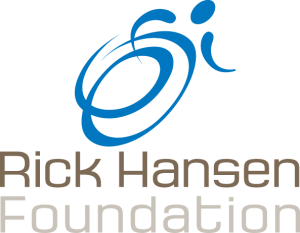 The Rick Hansen Accessibility Team is helping to break down barriers to access
The Rick Hansen Accessibility Team is helping to break down barriers to access
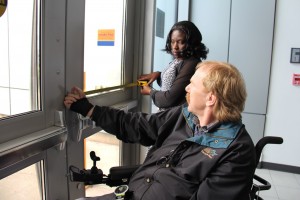
Accessibility Team members Stan (left) and Laetitia (right) measure the width of a door during an accessibility assessment.
In the winter of 2014, the Rick Hansen Foundation welcomed a six-person Accessibility Team to help businesses and venues in the Lower Mainland improve their accessibility. To date, the Team has conducted over 67 free accessibility assessments in Richmond, Vancouver, North and West Vancouver and Surrey, showcasing the importance of barrier-free design and helping venues highlight their access features.
Clients include Earls Restaurants, The Keg Steakhouse, and Boston Pizza–all of whom have demonstrated their commitment to accessibility by participating in the Program.
Not only are businesses benefiting, so are Accessibility Team Members themselves.
“I especially value the diversity in the group,” says Team member Mallaz Khalil. “The diversity is not only in the different physical challenges manifested in the group, but also in the different talents the team brings in together while working towards a common goal using different sets of skills.”
The Team’s efforts have been so well received that the BC Job Creation Program of the Government of British Columbia has extended the project until December 2015. The Program offers employment opportunities specifically for British Columbians with disabilities who have traditionally been underemployed.
Know of a business or venue that would like an accessibility assessment? Visit www.rickhansen.com/accessteam or call 778-296-1539.
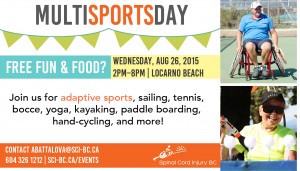 Multi-Sports Day
Multi-Sports Day
Try your hand at a variety of outdoor activities on August 26 when Spinal Cord Injury hosts its 2015 Multi-Sports Day at Vancouver’s Locarno Beach. Whether you’re looking to hit the water (sailing, paddle boarding, and kayaking) or prefer your sports on land (bocce, tennis, hand-cycling), we have something fun and active for everyone. Wind down with some adaptive yoga and an evening barbeque near the beach. Click here for details. Contact Alfiya (email or 604-326-1212) to RSVP to this free event.
 Since 2001, the on-site Saturday Farm Market has provided a unique venue for experiential education and student research, including everything from agricultural business management and marketing to nutritional analysis. In addition to farm-fresh veggies, fruits, herbs, flowers, and free-range eggs from the UBC Farm, the Saturday Farm Market also features a variety of other local growers, bakers, craftspeople, prepared food, and live musicians.
Since 2001, the on-site Saturday Farm Market has provided a unique venue for experiential education and student research, including everything from agricultural business management and marketing to nutritional analysis. In addition to farm-fresh veggies, fruits, herbs, flowers, and free-range eggs from the UBC Farm, the Saturday Farm Market also features a variety of other local growers, bakers, craftspeople, prepared food, and live musicians.
- August 8, 15 + 22, starting at 9am.
Between the parking lot and the stalls, you will encounter dirt roads, grass and gravel, but no stairs. Click here for directions and more accessibility info.
The BC Eagles Provincial Sledge Hockey Team are having a fun fundraiser at Yagger’s Pub on Friday, August 14. For $25, you get a burger and beer (or non-alcoholic drink). There will be games, a raffle, and great company. Contact Kyle for your tickets.
Thanks for reading this issue of the ICORDian–we hope you enjoyed it! Please subscribe and have future issues delivered to your email box. If you have any comments about this issue or suggestions for future ones, please contact us.







